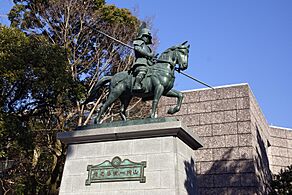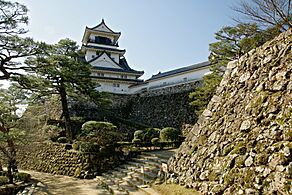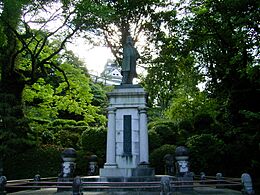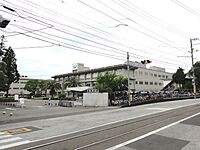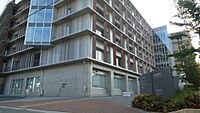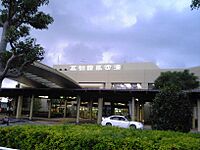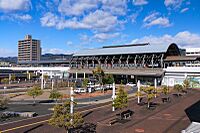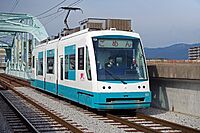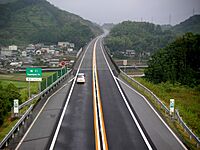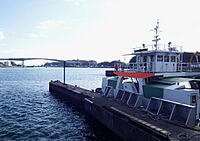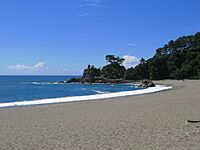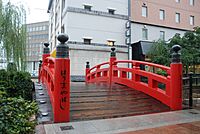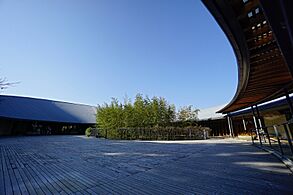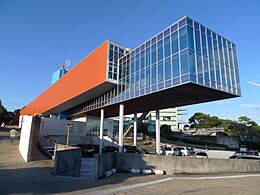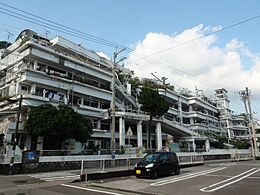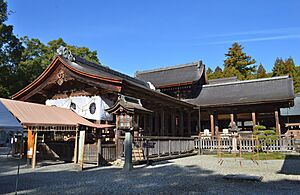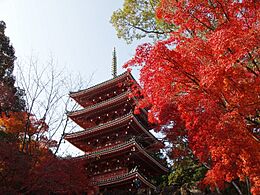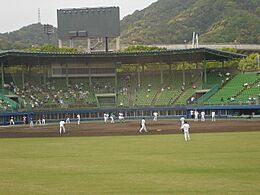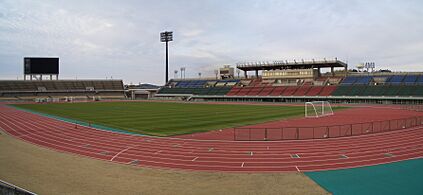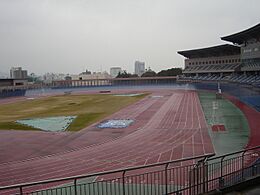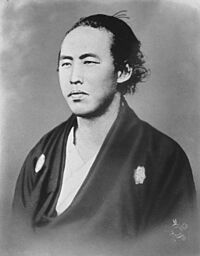Kōchi, Kōchi facts for kids
Quick facts for kids
Kōchi
高知市
|
|||||||||||||
|---|---|---|---|---|---|---|---|---|---|---|---|---|---|
| Kōchi City | |||||||||||||

From top left: Katsurahama, Statue of Sakamoto Ryoma, View of Kōchi from Mt. Godai, Yosakoi Festival, Harimayabashi, Tosa Electric Railway, Kōchi Castle
|
|||||||||||||
|
|||||||||||||
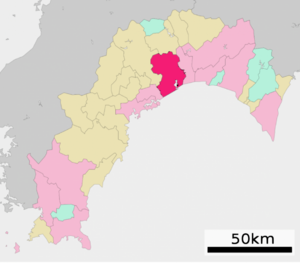 |
|||||||||||||
| Country | Japan | ||||||||||||
| Region | Shikoku | ||||||||||||
| Prefecture | Kōchi | ||||||||||||
| Area | |||||||||||||
| • Total | 309.00 km2 (119.31 sq mi) | ||||||||||||
| Population
(April 1, 2023)
|
|||||||||||||
| • Total | 318,520 | ||||||||||||
| • Density | 1,030.81/km2 (2,669.78/sq mi) | ||||||||||||
| Time zone | UTC+09:00 (JST) | ||||||||||||
| City hall address | 5-1-45 Honmachi, Kōchi-shi 780-0571 | ||||||||||||
|
|||||||||||||
Kōchi (高知市 (Kōchi-shi)) is a cool city in Japan. It is the capital of Kōchi Prefecture. You can find it on the island of Shikoku. Kōchi is a very important city for business and industry. More than 40% of the people in the prefecture live here.
As of April 1, 2023, about 318,520 people lived in Kōchi. The city covers an area of 309 square kilometers (about 119 square miles).
Contents
About Kōchi City
One of the most famous things about Kōchi is its special dish. It's called tataki and is made from bonito. The fish is lightly seared and seasoned. It's a must-try if you visit!
City Views
Kōchi has many interesting sights. You can see modern city buildings and busy shopping streets. There are also traditional Sunday markets. These markets stretch for almost a kilometer!
Geography and Climate
Kōchi is located on the southern coast of Kōchi Prefecture. It faces the Pacific Ocean. The city has three main parts. The city center is in a flat area near Urado Bay. Rivers like the Kagami River flow through it.
Mountains are to the north of the city. The highest point in Kōchi is Kuishi-yama, which is 1,176 meters (3,858 feet) tall. South of the city center, Urado Bay leads to the Pacific Ocean. This area has hills and is important for housing and port industries.
Nearby Towns and Cities
Kōchi is surrounded by other towns and cities in Kōchi Prefecture:
- Ino
- Nankoku
- Tosa City
- Tosa Town
Weather in Kōchi
Kōchi has a very wet climate. It gets twice as much rain as other big cities in Shikoku. It is also a city that often experiences typhoons. This is because it is directly on the Pacific Ocean. Sometimes, Kōchi has received over 50 centimeters (20 inches) of rain in one day from a typhoon!
| Climate data for Kochi (1991-2020 normals, extremes 1886-present) | |||||||||||||
|---|---|---|---|---|---|---|---|---|---|---|---|---|---|
| Month | Jan | Feb | Mar | Apr | May | Jun | Jul | Aug | Sep | Oct | Nov | Dec | Year |
| Record high °C (°F) | 23.5 (74.3) |
25.2 (77.4) |
26.3 (79.3) |
30.0 (86.0) |
32.3 (90.1) |
34.7 (94.5) |
38.3 (100.9) |
38.4 (101.1) |
37.3 (99.1) |
32.2 (90.0) |
28.0 (82.4) |
23.5 (74.3) |
38.4 (101.1) |
| Mean daily maximum °C (°F) | 12.2 (54.0) |
13.2 (55.8) |
16.3 (61.3) |
20.9 (69.6) |
24.8 (76.6) |
27.1 (80.8) |
30.8 (87.4) |
32.1 (89.8) |
29.5 (85.1) |
25.0 (77.0) |
19.6 (67.3) |
14.4 (57.9) |
22.2 (72.0) |
| Daily mean °C (°F) | 6.7 (44.1) |
7.8 (46.0) |
11.2 (52.2) |
15.8 (60.4) |
20.0 (68.0) |
23.1 (73.6) |
27.0 (80.6) |
27.9 (82.2) |
25.0 (77.0) |
19.9 (67.8) |
14.2 (57.6) |
8.8 (47.8) |
17.3 (63.1) |
| Mean daily minimum °C (°F) | 2.1 (35.8) |
3.1 (37.6) |
6.4 (43.5) |
10.9 (51.6) |
15.5 (59.9) |
19.7 (67.5) |
23.9 (75.0) |
24.5 (76.1) |
21.4 (70.5) |
15.6 (60.1) |
9.7 (49.5) |
4.2 (39.6) |
13.1 (55.6) |
| Record low °C (°F) | −7.6 (18.3) |
−7.9 (17.8) |
−6.5 (20.3) |
−0.9 (30.4) |
3.8 (38.8) |
9.1 (48.4) |
14.6 (58.3) |
15.9 (60.6) |
10.0 (50.0) |
2.5 (36.5) |
−1.9 (28.6) |
−6.6 (20.1) |
−7.9 (17.8) |
| Average precipitation mm (inches) | 59.1 (2.33) |
107.8 (4.24) |
174.8 (6.88) |
225.3 (8.87) |
280.4 (11.04) |
359.5 (14.15) |
357.3 (14.07) |
284.1 (11.19) |
398.1 (15.67) |
207.5 (8.17) |
129.6 (5.10) |
83.1 (3.27) |
2,666.4 (104.98) |
| Average snowfall cm (inches) | 0 (0) |
0 (0) |
0 (0) |
0 (0) |
0 (0) |
0 (0) |
0 (0) |
0 (0) |
0 (0) |
0 (0) |
0 (0) |
0 (0) |
1 (0.4) |
| Average precipitation days (≥ 0.5 mm) | 6.0 | 7.5 | 10.5 | 10.4 | 11.1 | 15.1 | 13.7 | 12.9 | 13.2 | 9.0 | 7.3 | 6.4 | 123.2 |
| Average relative humidity (%) | 61 | 60 | 62 | 65 | 70 | 78 | 79 | 76 | 74 | 68 | 68 | 64 | 69 |
| Mean monthly sunshine hours | 190.7 | 177.2 | 192.2 | 197.3 | 195.7 | 133.8 | 173.7 | 204.0 | 162.0 | 179.6 | 168.8 | 184.6 | 2,159.7 |
| Source: Japan Meteorological Agency | |||||||||||||
Population Changes
The number of people living in Kōchi grew quickly in the 1960s and 1970s. It reached its highest point around the year 2000. Since then, the population has slowly started to decrease.
| Historical population | ||
|---|---|---|
| Year | Pop. | ±% |
| 1920 | 133,277 | — |
| 1930 | 159,010 | +19.3% |
| 1940 | 163,182 | +2.6% |
| 1950 | 190,452 | +16.7% |
| 1960 | 221,737 | +16.4% |
| 1970 | 265,571 | +19.8% |
| 1980 | 318,266 | +19.8% |
| 1990 | 335,287 | +5.3% |
| 2000 | 348,979 | +4.1% |
| 2010 | 343,393 | −1.6% |
| 2020 | 326,545 | −4.9% |
History of Kōchi
Kōchi has a rich history. It was once part of an old province called Tosa Province.
Early Days and Castles
The city center started as a castle town around Kōchi Castle. This castle was the home of the local ruler, called a daimyō. The castle site was chosen in 1601. Kōchi city gets its name from this castle. Because it was the main center for the area, the town quickly grew.
-
Chōsokabe Motochika, an important historical figure.
Modern Times Begin
During the Meiji Restoration, Kōchi became known for its support of the emperor. It also became a place where people fought for more democracy and human rights. Kōchi officially became a city on April 1, 1889.
Trams started running in the city on May 2, 1904. The city was connected to Japan's national rail network on November 12, 1951.
World War II Air Raid
During World War II, Kōchi was bombed by the United States on July 3, 1945. Many planes dropped bombs, destroying almost half of the city. Sadly, 401 civilians lost their lives, and over 40,000 people lost their homes.
Recent History
On April 1, 1998, Kōchi was named the first "core city" on Shikoku island. This means it's a very important city for the region.
Later, some nearby villages and towns joined Kōchi:
- January 1, 2005: The villages of Kagami and Tosayama merged into Kōchi.
- January 1, 2008: The town of Haruno also became part of Kōchi.
Global Connections
Kōchi has special relationships with cities around the world. These are called "sister cities" or "friendship cities."
Sister Cities
Kōchi shares a close bond with these cities:
| City | Country | State | Since |
|---|---|---|---|
| Fresno | California | February 11, 1965 | |
| Surabaya | East Java | April 17, 1997 |
Friendship Cities
Kōchi also has friendship agreements with these cities:
| City | Country | State | since |
|---|---|---|---|
| Wuhu | Anhui | April 19, 1985 | |
| Mokpo | South Jeolla Province | November 9, 2012 |
Sister Ports
Kōchi's port also has special connections with other ports:
| City | Country | State | since |
|---|---|---|---|
| Subic Bay | Zambales | February 17, 1998 | |
| Port of Qingdao | Shandong | April 4, 1998 | |
| Port of Colombo | Colombo District | April 4, 1998 | |
| Port of Tanjung Perak | Surabaya | May 12, 1998 |
National Sister City
Kōchi also has a sister city within Japan:
| City | Region | Prefecture | Subprefecture | Since |
|---|---|---|---|---|
| Kitami | Hokkaidō region | Okhotsk | April 28, 1986 |
Education in Kōchi
Kōchi is a great place for learning. It has several universities and many schools.
Universities and Colleges
Kōchi is home to two main universities:
- Kōchi University (a national university)
- University of Kochi (a public university run by the prefecture)
There are also four junior colleges, including Kochi Junior College. Other universities include Kochi Gakuen University, The Open University of Japan, and University of Kochi Health Sciences.
Schools for Kids
The city government runs 39 public elementary schools and 17 public middle schools. There is also one public high school. In addition, Kōchi has private elementary schools and combined middle/high schools. The Kōchi Prefectural Department of Education also manages eight public high schools.
Getting Around Kōchi
Kōchi has many ways to travel, from airports to trams.
Air Travel
The closest airport is Kōchi Ryōma Airport. It is located in the nearby city of Nankoku.
Train Services
Kōchi is on the JR Shikoku's Dosan Line. This line connects Kōchi to northern Shikoku. You can also connect to other parts of Kōchi Prefecture. The main train station is Kōchi Station.
Local Train Stops
![]() Shikoku Railway Company JR Shikoku ■Dosan Line
Shikoku Railway Company JR Shikoku ■Dosan Line
- Tosa-Ōtsu
- Nunoshida
- Tosa-Ikku
- Azōno
- Kōchi
- Iriake
- Engyōjiguchi
- Asahi
- Kōchi-Shōgyō-Mae
- Asakura
Tram System
Trams are a very common way to get around Kōchi. The Tosaden Kōtsū company runs three tram lines. These lines cover the main routes across the city. You can even see historic tram cars!
- Tosaden Kōtsū Tram Lines
- ■Gomen Line
- ■Ino Line
- ■Sanbashi Line
Bus and Highways
Kōchi also has a large bus network. For longer trips, the Kōchi Expressway connects the city to the national highway system.
Main Highways
 Kōchi Expressway
Kōchi Expressway Kōchi-Tōbu Expressway
Kōchi-Tōbu Expressway
National Routes
 National Route 32
National Route 32 National Route 33
National Route 33 National Route 55
National Route 55 National Route 56
National Route 56 National Route 194
National Route 194 National Route 195
National Route 195
Sea Travel
The Port of Kōchi is important for shipping and trade.
Things to See and Do
Kōchi has many exciting places to visit, from old castles to beautiful gardens.
Kōchi Castle is a major attraction. It still looks much like it did hundreds of years ago! In the city center, you can explore the Obiyamachi (帯屋町) shopping area. Don't miss the long Sunday street markets. Another famous spot is Harimayabashi (はりまや橋), a bridge known from a local love song.
Local Attractions
- Godaisan Mountain: This mountain has a public park with amazing views of the city. It's also home to Chikurin-ji, a temple that is stop 31 on the Shikoku Pilgrimage.
- Makino Botanical Garden: Located on Godaisan, this garden is a paradise for plant lovers.
- The Museum of Art, Kōchi: This museum features art, especially works related to Kōchi.
- Former Yamauchi Residence: You can visit this historic home and the Tosa Yamauchi Family Treasury and Archives.
Historic Places
Kōchi is full of history.
- Castles
- Kōchi Castle
- Urado Castle ruins (remains of an older castle)
- Shrines and Temples
- The Shinto Shrine Tosa jinja is a beautiful place to visit.
- Several temples from the Shikoku Pilgrimage are in Kōchi:
- No. 30: Zenrakuji
- No. 31: Chikurin-ji
- No. 33: Sekkei-ji
Near Urado Bay, you can see the ruins of Urado Castle. Below it is Katsurahama, a famous beach. Here you'll find an aquarium and a statue of the Kōchi hero Sakamoto Ryōma. The Sakamoto Ryōma Memorial Museum is also nearby.
Culture and Fun
Kōchi has a lively culture with exciting festivals and delicious food.
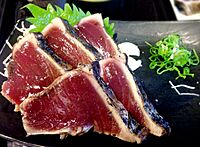
Festivals and Events
Kōchi's most famous event is the Yosakoi Festival. It happens every August. Thousands of dancers perform to traditional and modern music all over the city. It's a huge, colorful celebration!
- Yosakoi Festival
- Sunday street markets
Local Food to Try
- Katsuo-no-tataki: Lightly seared bonito, a local specialty.
- Katsuobushi: Dried, fermented, and smoked skipjack tuna.
- Sawachi Sushi: A large platter of various sushi and other dishes.
- Tosa-maki: A type of sushi roll.
Museums to Explore
- Kōchi Castle Museum of History
- Kōchi Literary Museum
- Ryōma's Birthplace Memorial Museum
- Sakamoto Ryōma Memorial Museum
- The Museum of Art, Kōchi
Sports in Kōchi
Kōchi is home to a few sports teams:
| Club | Sport | League | Venue | Established |
|---|---|---|---|---|
| Kōchi Fighting Dogs | Baseball | Shikoku Island League Plus | Kochi Municipal Baseball Park, Kochi Prefectural Haruno Baseball Stadium | 2005 |
| Kochi United SC | Soccer | Japan Football League | Kochi Haruno Athletic Stadium | 2016 |
-
Kochi Racecourse, where you can watch Horse racing.
Famous People from Kōchi
Many notable people have come from Kōchi.
- Nakahama Manjirō (1827–1898): One of the first Japanese people to visit the United States. He was important in helping Japan open up to the world.
- Okada Izō (1832–1865): A famous samurai from the late Edo period.
- Sakamoto Ryōma (1836–1867): A key leader who helped bring down the old government during the Bakumatsu period.
- Itagaki Taisuke (1837–1919): A politician who led movements for democracy and human rights in Japan. He helped create Japan's first political party.
- Tsutomu Seki (born 1930): An astronomer who has discovered many comets and asteroids.
- Nobuo Uematsu (born 1959): A famous video game composer, known for his music in the Final Fantasy series.
- Ryōko Hirosue (born 1980): An actress and pop star. She is known for her roles in films like Wasabi and Departures.
- Aaron Zagory (born 1985): A former US college football player who was a kicker for Stanford University.
- Sumi Shimamoto (born 1954): An anime voice actress. She voiced Kyoko Otonashi in Maison Ikkoku and Nausicaa in Nausicaa of the Valley of the Wind.
- Noa Tsurushima (born 2001): A model and actress, known for her roles as Is and As in Kamen Rider Zero-One.
- Tomitaro Makino (1862–1957): A pioneering botanist, often called the Father of Japanese Botany.
- Kusunose Kita (1836–1920): An important supporter of women's rights in Japan, especially in Kōchi.
- Tetsuya Nomura (born 1970): A video game artist, designer, and director at Square Enix. He is famous for designing characters in the Final Fantasy series.
- Nakamura Kazuha (born 2003): A member of the Korean girl group Le Sserafim.
- Nonaka Shana (born 2003): A member of the Korean girl group Lapillus.
- Hideshi Matsuda (born 1954): A racing driver and TV reporter.
- Fumio Nutahara (born 1963): A rally driver.
- Toshiko Okanoue (born 1928): A talented artist.
See also
 In Spanish: Kōchi (Kōchi) para niños
In Spanish: Kōchi (Kōchi) para niños













